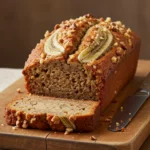There’s something truly special about starting the day with a warm, freshly baked scone. Forget the overly sweet, crumbly versions you might find at a coffee shop; these Rosemary, Parmesan, and Ham Scones are in a league of their own. When I first stumbled upon Ashley Manila’s recipe, I was intrigued by the savory combination. My family, always eager taste testers, were instantly hooked after the first bite. The aroma of rosemary mingling with the salty parmesan as they bake is simply irresistible. The texture is perfect – slightly crumbly yet moist, with a delightful chewiness thanks to the ham and cheese. These scones are not just breakfast; they are a delightful brunch centerpiece, a satisfying afternoon snack, or even a wonderful accompaniment to a light soup for dinner. They are remarkably easy to make, and the flavor payoff is immense. Trust me, once you try these savory scones, you’ll be adding them to your regular baking rotation.
Ingredients: The Foundation of Flavorful Rosemary, Parmesan, and Ham Scones
The quality of ingredients truly shines in these Rosemary, Parmesan, and Ham Scones. Each component plays a vital role in creating the perfect balance of textures and flavors. Let’s break down each ingredient and understand its importance:
- 2 and 1/2 cups all-purpose flour (not packed): Flour is the backbone of any scone recipe. All-purpose flour provides the structure and chewiness we desire. It’s crucial to measure flour correctly – spoon it into your measuring cup and level it off with a straight edge, avoiding packing it down. Packed flour can lead to dry, dense scones. For best results, opt for unbleached all-purpose flour, which has a slightly higher protein content and contributes to a better texture. If you’re looking for a slightly different texture, you could experiment with a mix of all-purpose and pastry flour, but for this recipe, all-purpose works perfectly.
- 1/2 teaspoon salt: Salt is a flavor enhancer, and in baking, it’s essential for balancing sweetness and bringing out the other flavors. In savory scones like these, salt is even more critical as it complements the parmesan and ham beautifully. Don’t skip the salt, as it prevents the scones from tasting flat and bland. Regular table salt or fine sea salt works well in this recipe.
- 1 tablespoon baking powder: Baking powder is a leavening agent that makes the scones rise and become light and airy. It’s a combination of baking soda and an acid, usually cream of tartar. Make sure your baking powder is fresh for the best results; old baking powder may lose its potency, leading to flat scones. Double-acting baking powder is commonly used and works well here.
- 1/2 teaspoon baking soda: Baking soda, also a leavening agent, reacts with acidic ingredients (though minimal in this recipe) and baking powder to create lift. While the main leavening comes from baking powder, baking soda contributes to the overall texture and helps achieve a slightly tender crumb. Using both baking powder and baking soda ensures a good rise and a balanced texture.
- 1/3 cup light brown sugar, packed: Brown sugar might seem unusual in savory scones, but it adds a subtle sweetness that balances the saltiness of the parmesan and ham. The molasses in brown sugar also contributes to moisture and a slightly softer texture. Light brown sugar is preferred as it provides a milder sweetness compared to dark brown sugar. Packing the brown sugar ensures accurate measurement.
- 1 stick (4 ounces) unsalted butter, VERY cold and cut into tiny pieces: Cold butter is arguably the most crucial ingredient for tender, flaky scones. The cold butter, when mixed into the dry ingredients, creates pockets of fat that melt during baking, resulting in a light and crumbly texture. Unsalted butter is recommended to control the salt content, especially since parmesan and ham are already salty. Cutting the butter into tiny pieces makes it easier to incorporate into the flour mixture and ensures it stays cold. For best results, you can even freeze the butter for 10-15 minutes before cutting it.
- 1 large egg, at room temperature: Eggs add richness, moisture, and structure to the scones. Using a room temperature egg ensures it emulsifies better with the other ingredients, creating a smoother dough. If you forget to take your egg out of the refrigerator, you can quickly warm it by placing it in a bowl of warm (not hot) water for a few minutes.
- 3/4 cup plus 2 tablespoons whole milk (full-fat): Milk provides moisture and helps bind the ingredients together. Whole milk is preferred over low-fat or skim milk because its higher fat content contributes to a richer flavor and a more tender crumb. The amount of milk might need slight adjustment depending on the humidity and the dryness of your flour, but start with the specified amount and add a tablespoon at a time if the dough seems too dry.
- 4 ounces Parmesan cheese, shredded: Parmesan cheese is the star of the savory flavor profile. Its salty, nutty, and slightly sharp taste complements the rosemary and ham beautifully. Freshly grated parmesan is highly recommended for the best flavor and texture. Pre-shredded parmesan often contains cellulose, which can affect melting and texture. Use a good quality Parmesan Reggiano for the most authentic flavor.
- 4 ounces ham, diced: Ham adds a savory, salty, and meaty element to the scones. Diced ham provides little pockets of deliciousness throughout the scone. You can use leftover cooked ham, deli ham, or even prosciutto for a more intense flavor. Ensure the ham is diced into small pieces so it distributes evenly in the dough and doesn’t make the scones too bulky. You can also experiment with different types of ham, such as smoked ham or Black Forest ham, for variations in flavor.
- 1/4 cup fresh rosemary, chopped: Fresh rosemary provides a fragrant, piney, and slightly peppery aroma and flavor that is quintessential to these scones. Fresh rosemary is significantly more flavorful than dried rosemary. Chop the rosemary finely to ensure it distributes evenly and doesn’t become overpowering. If you absolutely must use dried rosemary, use about 1 tablespoon and keep in mind the flavor will be less vibrant. Other herbs like thyme or chives could be used as variations, but rosemary is truly the perfect complement to parmesan and ham.
Instructions: Baking Rosemary, Parmesan, and Ham Scones to Golden Perfection
Follow these step-by-step instructions to bake perfect Rosemary, Parmesan, and Ham Scones every time:
- Preheat oven to 400°F (200°C). Line a large baking sheet with parchment paper; set aside. Preheating the oven to the correct temperature is crucial for even baking. 400°F (200°C) is the ideal temperature for scones, ensuring they bake through without drying out too quickly. Lining the baking sheet with parchment paper prevents the scones from sticking and makes cleanup a breeze. Parchment paper also helps with even browning of the scone bottoms.
- In a large bowl add the flour, salt, baking powder, baking soda, and brown sugar; mix well to combine. This step ensures that all the dry ingredients are evenly distributed before adding the wet ingredients. Whisking or using a fork to mix the dry ingredients helps to aerate the flour, which contributes to a lighter texture. Make sure there are no clumps of baking powder or brown sugar.
- Cut the butter into small cubes then quickly work it into the mixture (using your fingers, two forks, or a pastry cutter) until it resembles a coarse meal. Set aside. This is a critical step for achieving the desired scone texture. The goal is to incorporate the cold butter into the flour mixture without melting it. Working quickly and efficiently is key. You can use your fingertips, pressing and rubbing the butter into the flour until it resembles coarse breadcrumbs or small peas. Alternatively, use two forks in a scissor-like motion or a pastry cutter to cut the butter into the flour. Don’t overwork the mixture; you want to leave small pieces of butter intact. Setting aside the mixture at this stage allows the butter to stay cold while you prepare the wet ingredients.
- In a small bowl whisk together the egg and milk, beating well to combine. Add the liquid mixture to dry and use a fork to stir everything together until just moistened. Whisking the egg and milk together ensures they are fully combined and slightly aerated. Adding the liquid mixture to the dry ingredients in stages and stirring with a fork is crucial to prevent overmixing. Overmixing develops gluten, which can result in tough, dense scones. Stir just until the dry ingredients are moistened and a shaggy dough forms. It’s okay if there are still some streaks of flour.
- Add in the Parmesan cheese, ham, and rosemary and gently fold them into dough with a spatula. Once the dough is just moistened, gently fold in the parmesan cheese, diced ham, and chopped rosemary. Use a spatula and a light hand to distribute the ingredients evenly throughout the dough without overworking it. Folding minimizes gluten development and keeps the scones tender.
- Pour the shaggy dough out onto a clean, floured work surface and shape the dough into an 8-inch circle. Cut the dough into 8 wedges and carefully transfer to the prepared sheet. Lightly flour your work surface to prevent the dough from sticking. Gently pour the shaggy dough onto the floured surface. Use your hands to gently pat and shape the dough into an 8-inch circle, about ¾ to 1 inch thick. Avoid kneading or pressing too hard, as this will make the scones tough. Use a sharp knife or a bench scraper to cut the circle into 8 even wedges, like slices of a pie. Carefully transfer each wedge to the prepared baking sheet, leaving some space between them for air circulation.
- Bake for 18-20 minutes, or until the tops are lightly golden brown. Bake in the preheated oven for 18-20 minutes, or until the scones are lightly golden brown on top and cooked through. The baking time may vary slightly depending on your oven, so keep an eye on them. A toothpick inserted into the center of a scone should come out clean. The scones should be firm to the touch and have a slightly golden brown color.
- Cool for 5 minutes on the tray, then serve warm. Once baked, let the scones cool on the baking sheet for about 5 minutes before transferring them to a wire rack or serving plate. This allows them to set slightly and prevents them from breaking apart. These Rosemary, Parmesan, and Ham Scones are best served warm, when they are at their most tender and flavorful.
Nutrition Facts: A Savory Treat in Moderation
While these Rosemary, Parmesan, and Ham Scones are incredibly delicious, it’s good to be mindful of their nutritional content. Please note that these are approximate values and can vary based on specific ingredient brands and portion sizes.
- Servings: 8 scones
- Approximate Calories per serving: 320-380 calories (This is an estimate and can vary depending on ingredient quantities and specific brands. It is always best to use a nutrition calculator with the exact brands you use for more precise values).
Please note: This calorie count is an estimate. Factors such as the type of ham, the fat content of the parmesan, and the exact measurements of ingredients can influence the final calorie count. For a more precise nutritional breakdown, you can use online nutrition calculators and input the specific brands and quantities of ingredients you used.
Preparation Time: From Pantry to Plate in Under 40 Minutes
These Rosemary, Parmesan, and Ham Scones are surprisingly quick and easy to make, perfect for a weekend brunch or a weekday breakfast treat.
- Prep Time: 15 minutes
- Cook Time: 20 minutes
- Total Time: 35 minutes
This total time includes everything from gathering your ingredients to pulling the golden brown scones out of the oven. The active prep time is minimal, making this a fantastic recipe for even beginner bakers.
How to Serve Rosemary, Parmesan, and Ham Scones: Elevating Your Scone Experience
These savory scones are incredibly versatile and can be enjoyed in various ways, for different meals and occasions. Here are some serving suggestions:
- Breakfast or Brunch:
- Simply warm: Enjoy them warm straight out of the oven or lightly reheated. They are delicious on their own, showcasing their savory flavors.
- With Eggs: Serve alongside scrambled, poached, or fried eggs for a complete and satisfying breakfast or brunch.
- Avocado and Sliced Tomatoes: Top a warm scone with mashed avocado and sliced tomatoes for a light and fresh brunch option.
- Smoked Salmon and Cream Cheese: Split a scone and spread with cream cheese, then top with smoked salmon and a sprinkle of fresh dill for a more elegant brunch dish.
- Lunch or Light Dinner:
- Soup Companion: Serve warm scones alongside a hearty soup, such as tomato soup, potato soup, or a creamy vegetable soup. They are perfect for dipping and soaking up the delicious broth.
- Salad Side: Pair them with a fresh green salad or a Caesar salad for a light and satisfying lunch or dinner.
- Charcuterie Board Addition: Include these scones on a charcuterie board with cheeses, cured meats, olives, and other savory snacks for a sophisticated appetizer or light meal.
- Snacks and Appetizers:
- Warm Snack: Enjoy them as a warm afternoon snack with a cup of tea or coffee.
- Party Appetizer: Cut the scones into smaller bite-sized pieces and serve them as appetizers at a party or gathering. They are always a crowd-pleaser.
- Savory Tea Sandwiches: Split the scones and fill them with cream cheese and cucumber, or ham and cheese for unique savory tea sandwiches.
- Toppings and Accompaniments:
- Flavored Butter: Serve with flavored butter, such as garlic butter, herb butter, or roasted red pepper butter, to enhance the savory flavors.
- Honey or Jam (Surprisingly Delicious!): While savory, a touch of sweetness can surprisingly complement the flavors. Try a drizzle of honey or a dollop of fig jam for an unexpected twist.
- Cream Cheese or Herbed Cream Cheese: A simple spread of cream cheese or herbed cream cheese is a classic and delicious pairing.
Additional Tips for Baking the Best Rosemary, Parmesan, and Ham Scones
To ensure your Rosemary, Parmesan, and Ham Scones turn out perfectly every time, keep these helpful tips in mind:
- Keep the Butter COLD: This is the golden rule for making tender scones. Cold butter creates steam when baking, resulting in those desirable pockets of air and a flaky texture. Make sure your butter is very cold straight from the refrigerator, and work quickly to incorporate it into the dry ingredients before it softens. As mentioned earlier, you can even freeze the butter briefly before using.
- Don’t Overmix the Dough: Overmixing develops gluten, which will make your scones tough and dense instead of light and tender. Mix the dry ingredients and wet ingredients just until they are combined and a shaggy dough forms. It’s okay if there are still some streaks of flour. Gentle handling is key throughout the process.
- Handle the Shaggy Dough Gently: Scone dough is meant to be shaggy and a bit sticky. Resist the urge to add more flour to make it easier to handle. Lightly flour your work surface and your hands when shaping the dough. Gentle patting and shaping, rather than kneading, will maintain the tender texture.
- Baking Time Can Vary: Oven temperatures can vary, so keep an eye on your scones during baking. Start checking for doneness around 18 minutes. They are ready when they are lightly golden brown on top and a toothpick inserted into the center comes out clean. If your oven tends to bake unevenly, rotate the baking sheet halfway through baking for even browning.
- Storage and Reheating: Rosemary, Parmesan, and Ham Scones are best enjoyed fresh and warm. However, you can store leftover scones in an airtight container at room temperature for up to 2 days or in the refrigerator for up to 4 days. To reheat, wrap them in foil and warm them in a preheated oven at 350°F (175°C) for about 5-8 minutes, or until heated through. You can also reheat them in the microwave, but they might lose some of their crispness. For longer storage, you can freeze baked scones. Wrap them individually in plastic wrap and then place them in a freezer bag. Freeze for up to 2 months. Thaw overnight in the refrigerator or reheat directly from frozen in the oven.
FAQ: Ingredient Inquiries for Rosemary, Parmesan, and Ham Scones
Let’s address some common questions about the ingredients in this delicious Rosemary, Parmesan, and Ham Scone recipe:
Q1: Can I use salted butter instead of unsalted butter?
A: While unsalted butter is recommended to control the overall saltiness of the scones, you can use salted butter if that’s what you have on hand. If using salted butter, reduce the amount of added salt in the recipe to ¼ teaspoon instead of ½ teaspoon. Taste the dough before baking and adjust salt if needed.
Q2: Can I use dried rosemary instead of fresh rosemary?
A: Fresh rosemary is highly recommended for its vibrant flavor and aroma. However, if you only have dried rosemary, you can use it. Use about 1 tablespoon of dried rosemary in place of ¼ cup of fresh rosemary. Keep in mind that dried rosemary has a more concentrated flavor, so use it sparingly. Fresh rosemary will provide a brighter, more nuanced flavor that complements the parmesan and ham beautifully.
Q3: Can I substitute the ham with another type of meat?
A: Yes, you can definitely substitute the ham with other cooked meats to create variations of these savory scones. Good alternatives include:
* Cooked bacon, crumbled: Bacon will add a smoky and salty flavor.
* Cooked sausage, crumbled: Italian sausage or breakfast sausage would work well.
* Prosciutto, diced: Prosciutto will provide a more delicate and salty flavor.
* Cooked chicken or turkey, diced: For a leaner option.
Ensure the meat is cooked and diced into small pieces similar to the ham for even distribution in the scones.
Q4: What kind of Parmesan cheese is best to use for these scones?
A: For the best flavor, use freshly grated Parmesan Reggiano. Parmesan Reggiano is a high-quality, aged parmesan cheese with a rich, nutty, and complex flavor. Avoid using pre-shredded parmesan, as it often contains cellulose and may not melt as well, and the flavor is generally less intense. If you can’t find Parmesan Reggiano, look for a block of good quality parmesan cheese and grate it yourself.
Q5: Can I use different types of cheese in these scones?
A: Absolutely! While parmesan is the star in this recipe, you can experiment with other cheeses or cheese combinations to create different flavor profiles. Some cheese alternatives or additions that would work well include:
* Gruyere: Adds a nutty and slightly sweet flavor.
* Cheddar cheese (sharp or mild): Provides a classic cheesy flavor.
* Fontina: Offers a mild and creamy flavor that melts beautifully.
* Asiago: A semi-hard cheese with a nutty and slightly sharp flavor, similar to parmesan.
You can substitute all or part of the parmesan with one of these cheeses, or create a blend for a more complex flavor. Just ensure the cheese is shredded and incorporated evenly into the dough.
Enjoy baking and savoring these delightful Rosemary, Parmesan, and Ham Scones! They are sure to become a new favorite in your kitchen.
Print
Rosemary, Parmesan, and Ham Scones Recipe
Ingredients
- 2 and 1/2 cups all-purpose flour (not packed): Flour is the backbone of any scone recipe. All-purpose flour provides the structure and chewiness we desire. It’s crucial to measure flour correctly – spoon it into your measuring cup and level it off with a straight edge, avoiding packing it down. Packed flour can lead to dry, dense scones. For best results, opt for unbleached all-purpose flour, which has a slightly higher protein content and contributes to a better texture. If you’re looking for a slightly different texture, you could experiment with a mix of all-purpose and pastry flour, but for this recipe, all-purpose works perfectly.
- 1/2 teaspoon salt: Salt is a flavor enhancer, and in baking, it’s essential for balancing sweetness and bringing out the other flavors. In savory scones like these, salt is even more critical as it complements the parmesan and ham beautifully. Don’t skip the salt, as it prevents the scones from tasting flat and bland. Regular table salt or fine sea salt works well in this recipe.
- 1 tablespoon baking powder: Baking powder is a leavening agent that makes the scones rise and become light and airy. It’s a combination of baking soda and an acid, usually cream of tartar. Make sure your baking powder is fresh for the best results; old baking powder may lose its potency, leading to flat scones. Double-acting baking powder is commonly used and works well here.
- 1/2 teaspoon baking soda: Baking soda, also a leavening agent, reacts with acidic ingredients (though minimal in this recipe) and baking powder to create lift. While the main leavening comes from baking powder, baking soda contributes to the overall texture and helps achieve a slightly tender crumb. Using both baking powder and baking soda ensures a good rise and a balanced texture.
- 1/3 cup light brown sugar, packed: Brown sugar might seem unusual in savory scones, but it adds a subtle sweetness that balances the saltiness of the parmesan and ham. The molasses in brown sugar also contributes to moisture and a slightly softer texture. Light brown sugar is preferred as it provides a milder sweetness compared to dark brown sugar. Packing the brown sugar ensures accurate measurement.
- 1 stick (4 ounces) unsalted butter, VERY cold and cut into tiny pieces: Cold butter is arguably the most crucial ingredient for tender, flaky scones. The cold butter, when mixed into the dry ingredients, creates pockets of fat that melt during baking, resulting in a light and crumbly texture. Unsalted butter is recommended to control the salt content, especially since parmesan and ham are already salty. Cutting the butter into tiny pieces makes it easier to incorporate into the flour mixture and ensures it stays cold. For best results, you can even freeze the butter for 10–15 minutes before cutting it.
- 1 large egg, at room temperature: Eggs add richness, moisture, and structure to the scones. Using a room temperature egg ensures it emulsifies better with the other ingredients, creating a smoother dough. If you forget to take your egg out of the refrigerator, you can quickly warm it by placing it in a bowl of warm (not hot) water for a few minutes.
- 3/4 cup plus 2 tablespoons whole milk (full-fat): Milk provides moisture and helps bind the ingredients together. Whole milk is preferred over low-fat or skim milk because its higher fat content contributes to a richer flavor and a more tender crumb. The amount of milk might need slight adjustment depending on the humidity and the dryness of your flour, but start with the specified amount and add a tablespoon at a time if the dough seems too dry.
- 4 ounces Parmesan cheese, shredded: Parmesan cheese is the star of the savory flavor profile. Its salty, nutty, and slightly sharp taste complements the rosemary and ham beautifully. Freshly grated parmesan is highly recommended for the best flavor and texture. Pre-shredded parmesan often contains cellulose, which can affect melting and texture. Use a good quality Parmesan Reggiano for the most authentic flavor.
- 4 ounces ham, diced: Ham adds a savory, salty, and meaty element to the scones. Diced ham provides little pockets of deliciousness throughout the scone. You can use leftover cooked ham, deli ham, or even prosciutto for a more intense flavor. Ensure the ham is diced into small pieces so it distributes evenly in the dough and doesn’t make the scones too bulky. You can also experiment with different types of ham, such as smoked ham or Black Forest ham, for variations in flavor.
- 1/4 cup fresh rosemary, chopped: Fresh rosemary provides a fragrant, piney, and slightly peppery aroma and flavor that is quintessential to these scones. Fresh rosemary is significantly more flavorful than dried rosemary. Chop the rosemary finely to ensure it distributes evenly and doesn’t become overpowering. If you absolutely must use dried rosemary, use about 1 tablespoon and keep in mind the flavor will be less vibrant. Other herbs like thyme or chives could be used as variations, but rosemary is truly the perfect complement to parmesan and ham.
Instructions
- Preheat oven to 400°F (200°C). Line a large baking sheet with parchment paper; set aside. Preheating the oven to the correct temperature is crucial for even baking. 400°F (200°C) is the ideal temperature for scones, ensuring they bake through without drying out too quickly. Lining the baking sheet with parchment paper prevents the scones from sticking and makes cleanup a breeze. Parchment paper also helps with even browning of the scone bottoms.
- In a large bowl add the flour, salt, baking powder, baking soda, and brown sugar; mix well to combine. This step ensures that all the dry ingredients are evenly distributed before adding the wet ingredients. Whisking or using a fork to mix the dry ingredients helps to aerate the flour, which contributes to a lighter texture. Make sure there are no clumps of baking powder or brown sugar.
- Cut the butter into small cubes then quickly work it into the mixture (using your fingers, two forks, or a pastry cutter) until it resembles a coarse meal. Set aside. This is a critical step for achieving the desired scone texture. The goal is to incorporate the cold butter into the flour mixture without melting it. Working quickly and efficiently is key. You can use your fingertips, pressing and rubbing the butter into the flour until it resembles coarse breadcrumbs or small peas. Alternatively, use two forks in a scissor-like motion or a pastry cutter to cut the butter into the flour. Don’t overwork the mixture; you want to leave small pieces of butter intact. Setting aside the mixture at this stage allows the butter to stay cold while you prepare the wet ingredients.
- In a small bowl whisk together the egg and milk, beating well to combine. Add the liquid mixture to dry and use a fork to stir everything together until just moistened. Whisking the egg and milk together ensures they are fully combined and slightly aerated. Adding the liquid mixture to the dry ingredients in stages and stirring with a fork is crucial to prevent overmixing. Overmixing develops gluten, which can result in tough, dense scones. Stir just until the dry ingredients are moistened and a shaggy dough forms. It’s okay if there are still some streaks of flour.
- Add in the Parmesan cheese, ham, and rosemary and gently fold them into dough with a spatula. Once the dough is just moistened, gently fold in the parmesan cheese, diced ham, and chopped rosemary. Use a spatula and a light hand to distribute the ingredients evenly throughout the dough without overworking it. Folding minimizes gluten development and keeps the scones tender.
- Pour the shaggy dough out onto a clean, floured work surface and shape the dough into an 8-inch circle. Cut the dough into 8 wedges and carefully transfer to the prepared sheet. Lightly flour your work surface to prevent the dough from sticking. Gently pour the shaggy dough onto the floured surface. Use your hands to gently pat and shape the dough into an 8-inch circle, about ¾ to 1 inch thick. Avoid kneading or pressing too hard, as this will make the scones tough. Use a sharp knife or a bench scraper to cut the circle into 8 even wedges, like slices of a pie. Carefully transfer each wedge to the prepared baking sheet, leaving some space between them for air circulation.
- Bake for 18-20 minutes, or until the tops are lightly golden brown. Bake in the preheated oven for 18-20 minutes, or until the scones are lightly golden brown on top and cooked through. The baking time may vary slightly depending on your oven, so keep an eye on them. A toothpick inserted into the center of a scone should come out clean. The scones should be firm to the touch and have a slightly golden brown color.
- Cool for 5 minutes on the tray, then serve warm. Once baked, let the scones cool on the baking sheet for about 5 minutes before transferring them to a wire rack or serving plate. This allows them to set slightly and prevents them from breaking apart. These Rosemary, Parmesan, and Ham Scones are best served warm, when they are at their most tender and flavorful.
Nutrition
- Serving Size: one normal portion
- Calories: 320-380 calories





